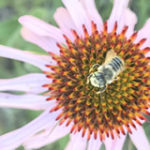V19-1, Fall 2005 – “The Da Vinci Code in Gardening,” by Steven Bartlett (reprinted from the Salem Hardy Plant Society) discusses the Fibonacci sequence in plants and explains how it is a secret of efficiency; “Plant Profile: Prairie Coneflower” by Susan R. Winslow, PMC Agronomist (reprinted from Plant Materials Today) nicely describes this plant and tells about the seed that has been made commercially available through the Bridger Plant Materials Center; Annie Garde and Diane Hafeman review “Wildflowers of Glacier National Park and Surrounding Areas” by Shannon Fitzpatrick Kimball and Peter Lesica; Vicky Lawrence offers a Small Grant Report: “Flower Creek Restoration Project”; the Awards Committee reported, and “Al Joyes Receives the MNPS Outstanding Service Award”. This issue also includes some really great field trip reports.
V19-2 Winter 2006 – Confused about G5/S1 or G2/S5? – Scott Mincemoyer describes the background of these ratings in, “Montana Plant Species of Concern: from Acorus americanus to Zizia aurea”; a role is ascribed for Castilleja spp. in the blister rust life cycle in “Rocky Mountain Research Station Pathology Group at Moscow Identifies New North American Alternate Hosts in the Life Cycle of the White Pine Blister Rust Fungus”; Catherine A. Schloeder and Betty Kuropat review D. Linnell Blank’s lovely and informative book, Montana Wildflowers; Linda Iverson prescribes the use of “Natives in the Winter Garden”; in a reprint from the Oregon NPS bulletin, Rhoda Love tells us, “’Mt. Fops’ Pussy-toes, or Why Study the Lives of Historic Botanists?”; Cathie Jean and Jay Frederick highlight, “Common Snowberry, Decorative White Fruit;” Erich Pfalzer contributes an informative piece, “Plants of Subalpine Parks with Peter Lesica – a Field Trip Report”; and “More on Prairie Coneflower” is offered by Linda Iverson along with a note from Wayne Phillips’s Central Rocky Mountain Wildflowers.
V19-3, Spring 2006 – “Water Moves in Mysterious Ways” by Peter Lesica links evapotranspiration, hydraulic lift, and leaky surface roots among several native plants (with references); in “Auspicious Beginnings,” Rebecca Durham tells of the joys of restoring native plants in the garden; “Early Bloomers” buttercups in January; “My Favorite Garden Plants,” from Sheila Morrison includes Douglasia montana, Phlox kelseyi var. missoulensis, and Lomatium cous; in “Jove’s Buttercup Found in the Pryors,” Clayton McCracken describes a range-extending find of Ranunculus jovis; and Society news.
V19-4, Summer 2006 – “Focus on Valley Nursery: Cold Hardy Natives from the Helena Valley,” by Patrick Plantenberg & Kathy Lloyd focuses on nurseryman Clayton Berg and his methods of plant selection; in “Spread a Little Bit of Love,” Dennis Nichols credits his teacher Dr. Michael Britton for fostering his love of plants, and entreats us to pass the love along, including great information about glacier lily, Erythronium grandiflorum; Clayton McCracken notes observations of dead Kelseya uniflora tufts in on Sykes Ridge in the Pryor Mountains in “Is the Kelseya Dying?”; Jim Habeck documents the conflict between Morton Elrod and the copper industry in “Can Botanists Be Bought? – Professor Joseph W. Blankinship: ‘Professional Witness’”; and in “What’s a Tree to do? – Interactions between nutcrackers, squirrels, and bird-dispersed pines” by Adam M. Siepielski (reprinted from the Castelleja) reports the way natural selection has increased variation in pine cone morphology, mostly in limber pines.




